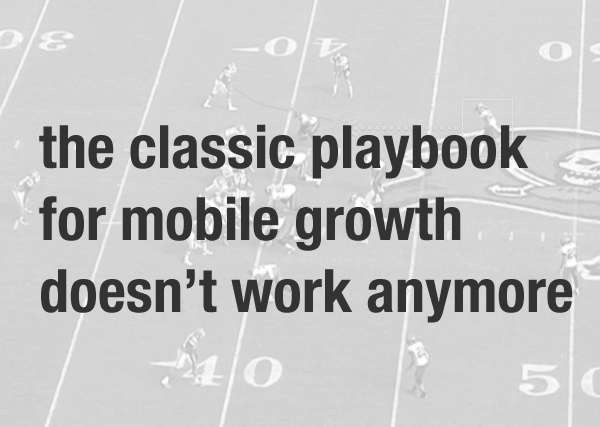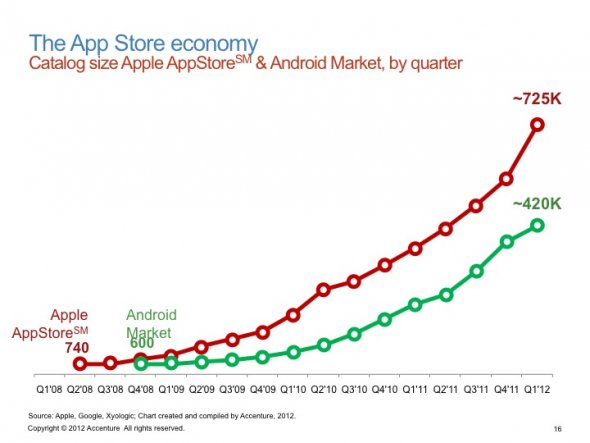Mobile traction is getting harder, not easier. Here’s why.
The “classic” growth formula for mobile is broken
Once upon a time, the formula for getting mobile traction was something like this:
- Build something insanely great
- Get Apple/Google to feature you, alongside a big PR launch!
- Watch your app hit the charts
- Buy some cheap installs to propel it even further
- Voila, hockey stick! (and hopefully not a shark fin)
This worked for a few memorable years, and things were good- especially for new startups and indie developers. But gradually this classic formula stopped working, with nothing equivalent to replace it. Getting initial traction on mobile has gotten a lot harder, even though you’d expect a richer and bigger mobile ecosystem to have emerged to increase the opportunities to achieve mobile growth. (ps. if you’re interested in developing new approaches to mobile growth, just email me.)
It was only a matter of time. As I argue in my essay The Law of Shitty Clickthroughs, all marketing strategies eventually result in shitty results over time. In marketing, first-movers trump (at least initially) – if you do something new, then you’ll see high response rates as people respond to the novel tactic, whether it’s a new kind of creative, a new acquisition channel, etc. Eventually though, as your tactics become industry-wide “best practices,” the response rates fall as your customers get used to the techniques.
History has repeated itself again, within the channels that drive mobile traction. Let’s discuss how the ecosystem has matured, including factors like: Increased app store competition, Higher CPI rates, editorial dynamics, and the overall investment trend.
Product differentiation is harder with a much bigger app store
Let’s cover the most obvious thing first- the number of apps has gotten a whole lot bigger. Whereas before a new app might be competing against non-consumption, in all the major mobile categories there’s been a huge increase in the total number of apps. Those that were successful in 2009-2010 are now facing 4-8X the competition, if you look at just the aggregate numbers.
Whether you’re building an app for photos, shopping, messaging, local, movies, or news, there are now 2-3 very high-quality competitors in each category. A new mobile developer is no longer competing against the first wave of amateur-built apps. These days, it’s much harder.
Below is a recent chart that shows the incredible growth in # of apps:
Cost Per Installs have gone up over time
Initially, buying an app install was relatively cheap. You had a lot of options- everything from mobile ad networks, incentivized install providers, “free app a day” services, and even more adventurous options. More importantly, not a ton of companies were doing it, so prices were low.
This Cost Per Install has skyrocketed though, both due to demand and a lack of supply. After only a short time, the supply of paid installs has contracted as Apple has banned some providers and warned others. Similarly, mobile games figured out the enormous monetization potential on iOS and Android – they’ve bid up the installs significantly, up to a few bucks per install.
Here’s a chart showing the increase in CPIs over the first half of 2012, though anecdotally I hear it’s much higher than this now:
Editorial teams further the platform’s own strategic goals
The editorial teams inside the Apple and Google stores can certainly help some apps, and they do. Yet they are skewed more towards the needs of the consumer, and to the goals of the platform.
For Apple, my impression is that they care more that the first 25 apps that a user installs are amazing experiences from well-known brands, rather than servicing the needs of the overall million apps that in the store. As a consumer, I surely appreciate this, but it doesn’t help new unknown developers break into the market.
For Google, any team that’s met with them in the last few quarters can tell you that they care a lot about tablet devices. While they are winning market share on phones, the numbers for iPad versus Android tablets show a different story. If you want to be featured in Google Play, they strongly encourage you build a tablet app even if the market for it is tiny. They also care a lot about Google+, but that’s another story.
Investment has dried up for experimental new consumer mobile apps
While investors still have an optimistic outlook for the overall mobile market, there doesn’t seem to be a lot of conviction to deploy their capital on risky new consumer mobile startups. My sense is that there’s a feeling the ‘great consumer mobile experiment of 2009-2012’ has been run, where a ton of seed capital went into a wide range of mobile companies, and now the motivations have changed.
Just look at how the composition of YCombinator Demo Day companies has changed- in the late-2011 event I attended, it was >50% consumer mobile. Now it’s SaaS, consumer hardware, marketplaces, etc. Mobile is often an aspect, but no longer the main focus.
The silver lining
Despite the difficulties outlined above, I’m still wildly optimistic about the future of mobile. It’s still the best platform upon which to build a new company, but we must choose to embrace and work around the new difficulties we’re facing in 2013. It’s not enough to simply repeat what worked in the past- otherwise we’ll have a new generation of mobile companies that fail like it’s 1999, as I’ve written about.
While it’s getting harder, the opportunities within mobile are still the largest since the beginning of the computer industry. We’re barely over majority smartphones within the US, as Nielsen reported last month (June 2013). While it’s impressive that some apps have reached 100M+ installs, in an overall market of billions, we’re just getting started. We have a lot to look forward to over the next 10 years.
PS. Get new updates/analysis on tech and startupsI write a high-quality, weekly newsletter covering what's happening in Silicon Valley, focused on startups, marketing, and mobile.
Views expressed in “content” (including posts, podcasts, videos) linked on this website or posted in social media and other platforms (collectively, “content distribution outlets”) are my own and are not the views of AH Capital Management, L.L.C. (“a16z”) or its respective affiliates. AH Capital Management is an investment adviser registered with the Securities and Exchange Commission. Registration as an investment adviser does not imply any special skill or training. The posts are not directed to any investors or potential investors, and do not constitute an offer to sell -- or a solicitation of an offer to buy -- any securities, and may not be used or relied upon in evaluating the merits of any investment.
The content should not be construed as or relied upon in any manner as investment, legal, tax, or other advice. You should consult your own advisers as to legal, business, tax, and other related matters concerning any investment. Any projections, estimates, forecasts, targets, prospects and/or opinions expressed in these materials are subject to change without notice and may differ or be contrary to opinions expressed by others. Any charts provided here are for informational purposes only, and should not be relied upon when making any investment decision. Certain information contained in here has been obtained from third-party sources. While taken from sources believed to be reliable, I have not independently verified such information and makes no representations about the enduring accuracy of the information or its appropriateness for a given situation. The content speaks only as of the date indicated.
Under no circumstances should any posts or other information provided on this website -- or on associated content distribution outlets -- be construed as an offer soliciting the purchase or sale of any security or interest in any pooled investment vehicle sponsored, discussed, or mentioned by a16z personnel. Nor should it be construed as an offer to provide investment advisory services; an offer to invest in an a16z-managed pooled investment vehicle will be made separately and only by means of the confidential offering documents of the specific pooled investment vehicles -- which should be read in their entirety, and only to those who, among other requirements, meet certain qualifications under federal securities laws. Such investors, defined as accredited investors and qualified purchasers, are generally deemed capable of evaluating the merits and risks of prospective investments and financial matters. There can be no assurances that a16z’s investment objectives will be achieved or investment strategies will be successful. Any investment in a vehicle managed by a16z involves a high degree of risk including the risk that the entire amount invested is lost. Any investments or portfolio companies mentioned, referred to, or described are not representative of all investments in vehicles managed by a16z and there can be no assurance that the investments will be profitable or that other investments made in the future will have similar characteristics or results. A list of investments made by funds managed by a16z is available at https://a16z.com/investments/. Excluded from this list are investments for which the issuer has not provided permission for a16z to disclose publicly as well as unannounced investments in publicly traded digital assets. Past results of Andreessen Horowitz’s investments, pooled investment vehicles, or investment strategies are not necessarily indicative of future results. Please see https://a16z.com/disclosures for additional important information.



